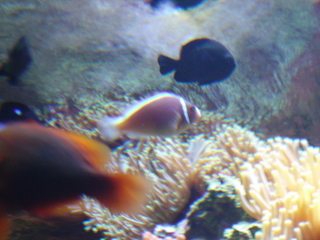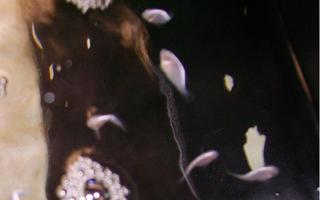We Have Clownfish Babies!!!
Retired
David
Monday, October 22, 2007
Stashed on a wet table behind the clownfish exhibit are two tiny acrylic vessels that serve as the nursery for clownfish fry. In the past, the Aquarium has had success breeding maroon clownfish, Premnas biaculeatus. Common clownfish, Amphiprion occellaris, are commonly bred in aquariums which is evident because the Aquarium has an exhibit dedicated to these fish. However, very few people have been able to breed pink skunk clownfish. Finally after two years of dedicated work, we have had success with these tiny critters and we hope to share them with the world soon.
In the wild, clownfish generally live in harems of more than 3 individuals where the largest, dominant member is the female while the smaller less dominant members are males. Clownfish are actually born as hermaphrodites having both male and female characteristics. When the dominant female in a harem dies, the most dominant male will take her place as the new female.
In an aquarium, however, clownfish pair up with one another and remain faithful to their choosen mate. The larger of the pair will take the role of the female and the smaller will take the role of the male. Each of the clownfish pairs in the exhibit then chooses a site to deposit their eggs, which is usually a flat, protected surface. The fry hatch approximately 4 days later. The difficult part with rearing clownfish fry is removing the fry from the exhibit so that they can be reared in peace. The parents take no part in the rearing of the young. They will protect their eggs but once the eggs hatch, the babies are on their own. The fry can get eaten by other fish, swept away or even eaten by their own parents! To prevent all this, the fish were trained to deposit their eggs on a tile so that once the eggs are deposited, they can be easily removed along with the tile and transferred to the nursery.
Once the clownfish hatch, they look like little black specks of pepper in the water. They have to be fed several times a day because when you are that small, you cannot fit much food in your tummy. The fry start off eating rotifers and slowly graduate to baby brine shrimp. When they grow big enough, they can take commercially prepared fish flakes, similar to what most people feed their goldfish. The nursery must be cleaned daily using a hydro-vacuum and the water quality must be pristine. The fry do not fare well in poor quality water.
Amy, the aquarist who made this all happen, has now put them on display in the Jewels of the Pacific exhibit in our Tropical Gallery.





